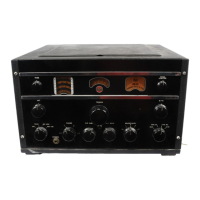equipped with a spade terminal, extends from the
cable. These leads should be connected
to
the power
unit terminal board - the brown lead
to
the terminal
marked
"A
- HOT," the yellow lead
to
"B-"
and the
red lead to
"B+."
Replace the terminal board cover
with the three
leads extending from the open end of
the cover, connecting the black lead under one of the
screws which hold the cover.
MOUNTING THE SWITCH - Fasten the switch
to
the bracket on the top of the transformer can.
CONNECTING THE POWER
CABLE
TO THE RE·
CEIVER
- Remove the plug from the socket on the
rear apron
of the receiver. Insert the plug, on the end
of the vibrator power supply cable, into this socket.
ADJUSTMENTS - A four.position rotary switch on
the rear of the chassis is used
to
adjust the vibrator
output voltage
to
compensate for variations in the
battery voltage. The positions
~ln
this switch are num·
bered from
"1"
to
"4"
inclusive. The position in which
the switch rotor is placed is indicated by the direction
in·
which the screw-driver slot in the rotor shaft is
pointing. For proper selection
of the switch position,
consult the following table:
Switch Position
4
3
2
1
Battery Voltage
6.0
to
6.5 volts
6.5
to
7.0 volts
7.0
to
7.5 volts
7.5 to 8.5 volts
CONNECTING THE POWER CABLE TO THE
STORAGE BATTERY -
Turn
the power switch in
the power cable
to
the
"OFF"
position. There are
two
battery clips connected
to
one end of the power cable.
each clip serving
to
terminate a pair of wires. On one
clip, both wires are black while
on
the other clip one
wire is green and the second is brown.
Connect the clip
with the
two
black wires securely
to
the negative
(-)
terminal of the storage battery.
Be
sure to make good
contact at this point.
Connect the clip with the green
and brown wires securely to the positive
(+)
terminal
of the battery. The receiver is
now
ready for operation
from the power supply unit.
NOTE - Since the power line cord supplied with the
receiver is completely out
0/
the circuit when the
vibrator power supply is used, this cord should
be
wound up and placed inside
01
the receiver case in the
_'pace
between the chassis and the case wall.
OPERATION
The switch
On
the power cable must
be
used for turn-
ing the receiver on
and
off,
the power switch on the
receiver being automatically cut out of the circuit
when the vibrator power supply unit
~s
used. To pre·
vent impairment of normal operation, the following
precautionary measures should be observed:
1.
Never remove the rectifier, tube while the power
supply unit is in operation.
Serious damage to circuit
elements,
or
even
to
the vibrator itself, may result
under these conditions.
2.
Never disconnect any leads on the power cable
unless the power switch is turned
oD.
Never tighten
any terminal screws unless the power is definitely
oD.
Should it become necessary
to
tighten any
or
all
of
the screws
on
the vibrator power unit terminal hoard,
always first remove the battery clips from the battery.
THIS
IS
EXTREMELY
IMPORTANT,
SINCE FAIL-
URE TO FOLLOW
THIS
RULE
WILL
INVARIABLY,
RESULT
IN
SERIOUS DAMAGE TO THE VI-
BRATOR
POWER
UNIT
ITSELF.
MAINTENANCE
A wiring diagram of the vibrator power supply unit is
shown in Figure
1.
The diagram symbol of each part
is repeated in the parts list
to
facilitate identification
by means of cross reference.
Service generally consists of replacing the vibrator
which may have deteriorated through prolonged usage.
If
excessive output hum should occur, during opera·
tion, the cause may
be
a filter-circuit breakdown, such
as leaky or
short·circuited filter capacitors.
25
When servicing the power supply unit, disconnect it
from its source of voltage supply and, using an
ohm-
meter, check through for continuity.
Capacitors should
be
tested by first removing one side
from the adjacent connections
so that the capacitor
under test is not connected in the circuit.
The power supply unit is protected
by
a IS.ampere
fuse which in the event of failure should
he
replaced
by
one of identical rating.

